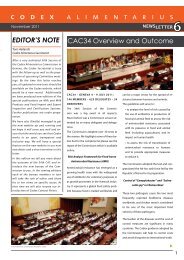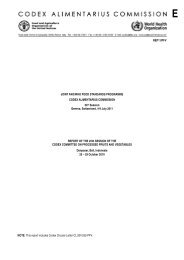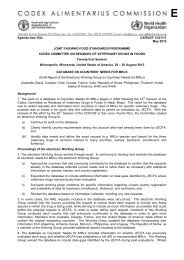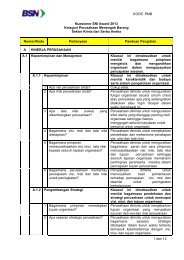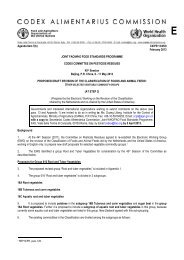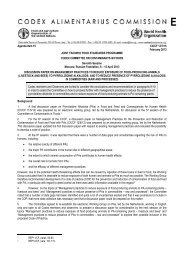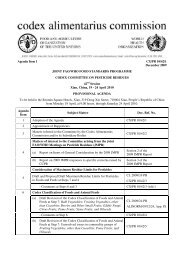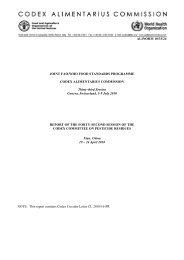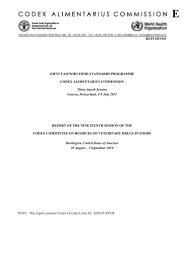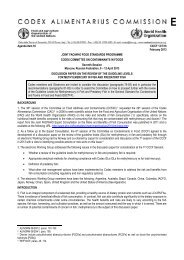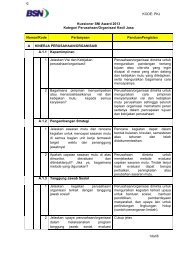alinorm 10/33/41 - CODEX Alimentarius
alinorm 10/33/41 - CODEX Alimentarius
alinorm 10/33/41 - CODEX Alimentarius
Create successful ePaper yourself
Turn your PDF publications into a flip-book with our unique Google optimized e-Paper software.
ALINORM <strong>10</strong>/<strong>33</strong>/<strong>41</strong> 974. In view of the above discussion, the Committee agreed to retain the proposed MLs for Shelled, ready to eatBrazil Nuts at <strong>10</strong> µg/kg and Shelled, destined for further processing Brazil Nuts at 15 µg/kg and not to set anymaximum level for in-shell Brazil nuts. The Delegation of Brazil expressed its reservation to the decision on inshellBrazil nuts.Sampling Plans for Brazil Nuts75. The Committee agreed that the sampling plans for total aflatoxins in Brazil nuts should be integrated intothe sampling plans for aflatoxin contamination in ready-to-eat treenuts and treenuts destined for further processingand amended the document accordingly. The Committee further noted that only those sections relating to Brazilnuts were for adoption by the Commission.Status of the Proposed Draft Maximum Levels for Total Aflatoxins in Shelled, Ready-to-Eat Brazil Nutsand Shelled, Destined for Further Processing Brazil Nuts (including sampling plans)76. The Committee agreed to forward the proposed draft Maximum Levels (including sampling plans) to the<strong>33</strong> rd Session of the Codex <strong>Alimentarius</strong> Commission for adoption at Step 5/8 (with omission of Steps 6 and 7)(Appendix V).PROPOSED DRAFT REVISION OF THE CODE OF PRACTICE FOR THE PREVENTION ANDREDUCTION OF AFLATOXIN CONTAMINATION IN TREE NUTS (Appendix on Additional Measuresfor Brazil nuts) (Agenda Item 7) 1177. The Delegation of Brazil introduced the document highlighting the additional measures for Brazil nuts thatshould be incorporated in the Appendix on Additional Measures for Brazil Nuts of the Code of Practice for thePrevention and Reduction of Aflatoxin Contamination in Tree Nuts (CAC/RCP 59-2005) following thecompletion of the Standards and Trade Development Facility (STDF) SafeNut Project which addressed the factorscausing aflatoxin contamination in the Brazil nut production chain and the methods of control available.78. Some delegations requested clarification as to what the “safe moisture level” should be to avoid aflatoxinformation as humidity was one of the critical environmental factors for fungal growth, especially in the rain forest,and therefore, a target level for moisture content was required in order to facilitate the application of the Code.These delegations further noted that the level of available water was the most important factor for aflatoxinproducing fungi so that both moisture content and the corresponding water activity (a w ) should be specified toensure that neither fungal growth nor production of the associated toxin could take place.79. The Delegation of Brazil explained that the provision in paragraph 8 could be amended by linking themoisture level to a water activity below 0.70, as already indicated in paragraph 11, since the actual moisture levelwas not yet possible to define because it may vary depending on the size of the nut. In this regard, the Delegationinformed about ongoing studies in Brazil to determine the correlation between the safe moisture level and theassociated water activity and that, when finished, the outcome of this study could be made available to theCommittee for incorporation in the Code. An Observer indicated that a safe moisture level for Brazil nuts hadalready been identified as 5% which corresponded to a water activity of 0.70.80. In view of the above considerations, the Committee agreed to refer to a safe moisture level corresponding toa water activity lower than 0.70 in the first sentence of paragraph 8.81. Some delegations requested clarification on the scientific basis for the recommended period of <strong>10</strong> daysbetween the collection and the processing (drying) of the nuts as laid down in the first sentence of paragraph 8.Several delegations indicated that, as sun-drying was not normally sufficient to reach a safe moisture level due tothe high relative humidity in the rain forest, an additional provision by which transport of Brazil nuts should bedone within <strong>10</strong> days after collection to an appropriate drying facility should be included at the end of the secondsentence of paragraph 8.82. The Delegation of Brazil explained that, in view of the unique characteristics of this product, which was notcultivated, a certain degree of flexibility should be allowed in order to take into account certain factors likedistance between the collection and the manufacture points, weather conditions, etc., that may affect the collectionof the nuts and their transport to the processing plants.11CX/CF <strong>10</strong>/4/7; CX/CF <strong>10</strong>/4/7-Add.1 (comments of Canada and Norway); CX/CF <strong>10</strong>/4/7-Add.2 (comments of Japanand Thailand); CRD 9 (comments of the EU); CRD 14 (comments of Bolivia); CRD 17 (comments of Brazil); CRD 22(comments of Ecuador).



